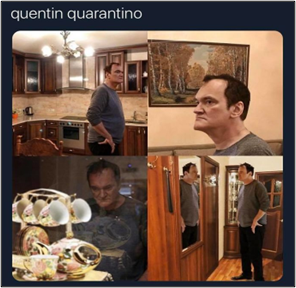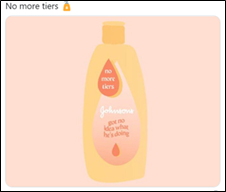For my BA dissertation, I looked at lockdown memes generated during the Coronavirus pandemic. Firstly, let me ask you a question; did you see any memes during lockdown? Unless you don’t participate in social media, I am sure everyone has sent or received a funny image or video that has made us laugh and feel better. The natural assumption is that memes are just funny images with a bit of text; however, on closer analysis we can see that they are linguistically rich, containing lots of modes like text and image to convey a humorous thought. Scholars have labelled memes as ‘social replicators’ because they comprise of images/texts that effectively communicate and reappropriate thoughts and ideas, particularly from the public, that imitate wider political and cultural beliefs. This makes memes, in particular lockdown memes, important to analyse.
The aims of my research were twofold; I wanted to uncover public perceptions about lockdown and the types of humour presented in lockdown memes. I also investigated how these concepts tied together: how the humour displayed in lockdown memes represents public perceptions about lockdown, and by extension the work of the government. As there were a vast array of memes online, I made sub-categories to focus my dissertation. These sub-categories were ‘staying at home,’ ‘working at home,’ ‘social distancing’ and ‘emerging themes’ (such as the ‘tier systems’) that transpired during the investigation. I also collected a specific format of meme called an ‘image-macro’. This is when the meme has top-text (writing at the top) and a picture, usually referred to as the bottom text.
In order to analyse my data, and my sub-categories of memes found online, I conducted a multimodal discourse analysis. With any qualitative research, we have to be mindful of the subjective nature of analysis and the influence of researcher opinions (something we call reflexivity), so it is important to define stages of analysis as transparently and objectively as possible. As my research questions aimed to find types of humour and public perceptions, I found three types of humour from prior literature that were common in memes.
The first type of humour was incongruity; this is essentially a comparison of two juxtaposing aspects. In memes, the top-text may say something, but the picture below represents the opposite to what is expected in the discourse system, and this is humorous. The second type of humour in memes is visual punning: a type of wordplay. Visual punning plays on the homophonic elements (similar sounds) of a word, and this is represented in both the text and image. In visual punning memes, the picture illustrates some of the sound element. The third type of humour was parody, which is known as the refunctioning of linguistic material. Memes may parody lockdown or particular government figures. As memes often refunction existing material for a humorous purpose, parody achieves this goal.
The findings of my dissertation showed that the visual punning category was particularly innovative and creative. One of the memes displayed ‘Quentin quarantino’ in the top text and represented humorous wordplay with pictures of ‘Quentin Tarantino’ underneath, in different parts of his home, as though he was quarantining. Tarantino’s name has been remixed with noun ‘quarantine’ as they are homophonically similar. The visual pun is created because although the nouns (quarantine and Tarantino) sound alike, they represent different entities. Additionally, another visual pun was Johnson’s baby wash. The top text ‘No more tiers’ is a homophone of ‘tears,’ relating to Johnson’s slogan: ‘No more tears.’ The homophone ‘tiers’ and ‘tears’ although sound similar, refer to different persons. Additionally, Johnsons and Boris Johnson share the same name, but refer to different concepts. The author of the meme has remixed the Johnson’s product (and name) to coincide with the lockdown genre, thus creating humour.
The incongruity category was also fascinating and made up 80% of my corpus. The high volume of incongruous memes showed that the public particularly enjoyed using incongruity to create humour. There were three themes in the incongruity category: ‘expectation vs reality’, ‘duration of lockdown’ and ‘extreme level of comparison.’ Authors liked to use the top-text of a meme to set up an expectation; however, the image below juxtaposes the expectation and represents the harsh reality of lockdown. Not only is this funny because it is unexpected from the caption, but many of the UK public could relate to the sad reality experienced during the pandemic. The theme represents how people expected things to be pre-lockdown, compared with the reality of what actually happened.
Incongruous memes also represented the duration of lockdown, and how in only a short amount of time, people felt as though they had aged or deteriorated. This shows that people felt the effects of lockdown and perceived the events negatively. The other type of incongruity humour was ‘me vs them.’ People liked to use the personal pronoun ‘me’ to compare with what other people were doing/achieving during lockdown. For instance, authors highlighted how other people are learning new skills during lockdown, compared to the ‘me’ characterisation who is lazy and day drinking. Additionally, some incongruous memes criticised the government directly. Johnson was depicted as a clown, showing that the public thought the government were ineffective with their guidelines and policies (like lockdown and the tier systems) during the pandemic.
The types of humour, and the subsequent public representations that they portrayed, demonstrate how people felt unmotivated and lazy, like they were doing worse than others in how they were coping, and the harsh realities of lockdown during 2020. What my dissertation research shows, through memes, is that people thought lockdown was a tough event and that many perceived governmental inefficiencies. In particular, we can identify that the purpose of lockdown memes was to alleviate some of the harsh realities of the pandemic, and reframe them in a humorous response, to provide temporary relief for the UK public. The sharing and receiving of these memes, provides solidarity and peer support during tough events – like a global pandemic. Therefore, it would be beneficial to analyse lockdown memes from a psychological perspective to see the cognitive and emotional benefits that provide temporary relief for engagers of memes.
By Katie Halley
(Postgraduate of MA Applied Linguistics)







